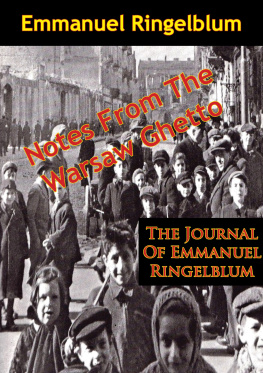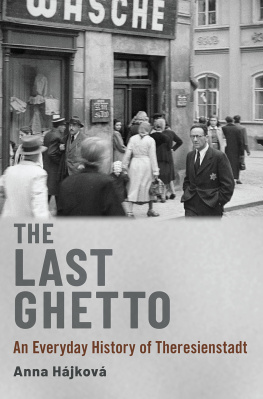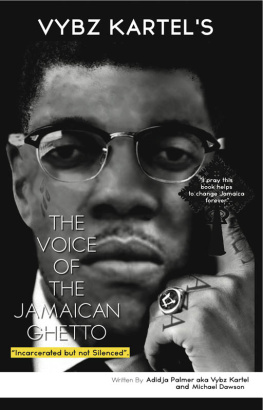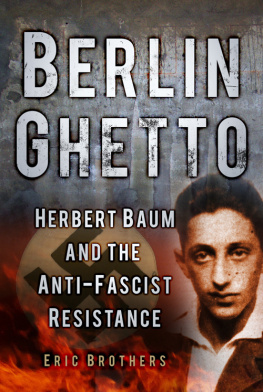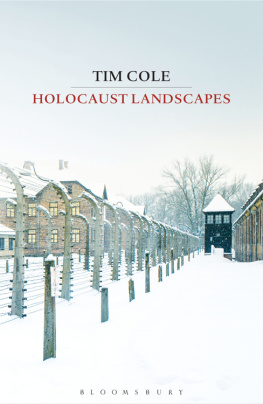HOLOCAUST
CITY
HOLOCAUST
CITY
The Making of a Jewish Ghetto
T I M C O L E
Published in 2003
by Routledge
2 Park Square, Milton Park, Abingdon, Oxon OX14 4RN
Simultaneously published in the USA and Canada
by Routledge
711 Third Avenue, New York, NY 10017, USA
Routledge is an imprint of the Taylor & Francis Group, an informa business
Copyright 2003 by Taylor & Francis Books, Inc.
All rights reserved. No part of this book may be reprinted or reproduced or utilized in any form or by any electronic, mechanical, or other means, now known or hereafter invented, including photocopying and recording, or in any information storage or retrieval system, without permission in writing from the publisher.
Library of Congress Cataloging-in-Publication Data
Cole, Tim, 1970
Holocaust city: the making of a Jewish ghetto / Tim Cole.
p. cm.
Includes bibliographical references and index.
ISBN 0415929687 (hardback) ISBN 0415929695 (pbk.)
JewsHungaryBudapestSocial conditions20th century. 2. Jewish ghettosHungaryBudapestHistory20th century. 3. HungarySocial policyHistory20th century. 4. HungarySocial conditions19181945. 5. HungaryEthnic relations. 6. Human geographyHungary. 7. Urban policyHungary. 8. Holocaust, Jewish (19391945)Hungary. I. Title.
DS135 .H92 C65 2003
940.531853912dc21 |
2002153070 |
ISBN - 978 0 4159 2969 1
F O R M Y P A R E N T S ,
R O G E R A N D C H R I S T I N E C O L E
CONTENTS
I loved playing with LEGO blocks as a kid. On Sunday afternoons my brother and I dragged the old plastic ice-cream containers full of colored bricks into the back room and built our own world. For a while we always built towers, one of which touched the ceiling but the next morning lay in ruins on the carpet. The bright plastic blocks are still at my parents' house, in the same old ice-cream containers, up on the top shelf in my old bedroom, from where they are brought down when the grandchildren visit. I got thinking back to those Sunday afternoons and the obsession of an eight- and a ten-year-old with LEGO, with the opening at the Jewish Museum in New York of the controversial art show Mirroring Evil. It opened in the spring of 2002, just as I was coming to the end of writing this book. Among the many pieces exhibited are the provocative works of the Polish artist Zbigniew Libera titled Correcting Device: LEGO Concentration Camp. This was not the first time they had been exhibited, far from it. First created in 1996, Libera's works had been causing controversy for a number of years.
As the exhibition curator, Norman Kleeblatt, recounted in the excellent catalogue that accompanied the exhibition, Libera's work had first come to his attention some years before. It was one of a number of pieces reflecting what he saw to be a shift in artistic representations of the Holocaust. For Kleeblatt, Libera was one of a new generation of artists who look at these events in a radically differentindeed disturbingway. They turned from what has become a standard focus on the often anonymous victims and
What I think is particularly powerful about Libera's provocative work is that he has purposefully chosen to allow the viewer to construct Auschwitz from something as everyday as LEGO bricks. Now, of course, the gallery visitor can choose to construct something else. That is after all the great attraction of LEGO building bricks to generations of kids, my brother and I included. They are an ultimately flexible tool in the hands of a child's imagination. But Libera is surely suggesting that the human imagination can think up places like Auschwitz,
In using such ordinary building blocks from this ubiquitous child's toy to create such extraordinary structures, Libera raised, I think, the kinds of questions that I seek to address in this book. They are questions that continue to be at the very forefront of thinking about the Holocaust. In short, face-to-face with a place like Auschwitz, the nagging question is who on earth would build such a place, and why on earth would they build it. As James Young reflects in his essay written for the exhibition catalogue, for these artists, the only thing more shocking than the images of suffering victims is the depravity of the human beings who caused such suffering.involvement of these professions in constructing the architecture of the Holocaust.
Perhaps more than anyone else, the historian Christopher Browning has explored the disturbing question of just how ordinary the motivations of those involved in implementing the Holocaust were in his groundbreaking study Ordinary Men. Although Browning examined specifically the actions and motivations of one Reserve Police Battalionnumber 101in Nazi-occupied Poland, his study has been taken as having a much broader relevance when thinking about why anyone would implement the Holocaust. His suggestion is that the reasons behind the involvement of the middle-aged Germans he looks at were ordinary in the extreme. And in a haunting section at the close of the book, he suggests that
the collective behavior of Reserve Police Battalion 101 has deeply disturbing implications. There are many societies afflicted by traditions of racism and caught in the siege mentality of war or threat of war. Everywhere society conditions people to respect and defer to authority, and indeed could scarcely function otherwise. Everywhere people seek career advancement. In every modern society, the complexity of life and the resulting bureaucratization and specialization attenuate the sense of personal responsibility of those implementing official policy. Within virtually every social collective, the peer group exerts tremendous pressures on behavior and sets moral norms. If the men of Reserve Police Battalion 101 could become killers under such circumstances, what group of men cannot?
Browning points to such ordinary motivations as concerns with career advancement and peer pressure leading to such extraordinary acts as the mass murder of Polish Jews.as Jews restricted to the place of the ghetto in 1944. What I'm interested in is how something so ordinary as the very spaces and places of a city was manipulated during 1944 to create distinct Jewish and non-Jewish space. In short, I'm interested in how a city became a Holocaust city, and ultimately I'm interested in that question which obsesses anyone who encounters the Holocaust: Why?
Tim Cole
Bristol
September 2002
Many people have helped me as I've spent over a decade asking the questions how and why the city of Budapest became a Holocaust city. Three people have been especially important. My parents, Roger and Christine Cole, to whom this book is dedicated, have taught me by their example that there are no such things as bad questions. Their nonconformist approach to life has influenced me profoundly. Without their example, help, and sup-port I would never have started out on the long path of intellectual inquiry, of which this book is one result. The other person who is a constant inspiration, as well as my companion on that path, is my wife, Julie. I first met her in Budapest in the summer of 1991, a few days after arriving in the city to embark upon learning Hungarian. And this book will be published just as she has our first child. Her love and friendship have meant so much to me over the last eleven years.
Alongside the love and support of my parents, and Julie, I feel privileged to have had so much help during the years since first starting out researching the Hungarian Holocaust. One important group has been friends in Budapest, Cambridge, Bristol, and Washington, D.C. In particular, I am very grateful to three friendsdm Szabados, Laci Smegi, and Tams Hmorwho offered their hospitality in Budapest and introduced me to their city and their country. In Cambridge, I am especially grateful for the friendship of my housemates Matthew (and Karen) Sleeman and Jeremy Lindsell, who shared the excitement and anguish of postgraduate study. It was Matthew who first got me thinking about doing a Ph.D. in the Geography Department at Cambridge on the Budapest ghetto, and who introduced me to Graham Smith who became my Ph.D. adviser. Graham was a wonderful adviser, who was always ready to offer advice and, perhaps most important, gave me self-belief that my ideas were worth exploring and expressing. One of my regrets is that Graham tragically died before that Ph.D. research ever resulted in a book.



